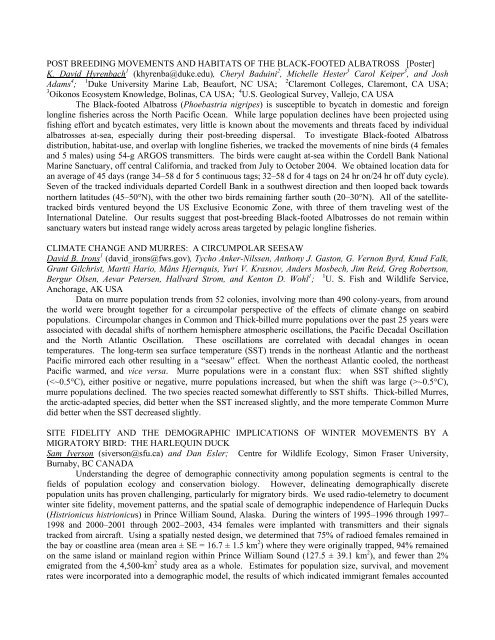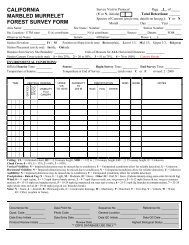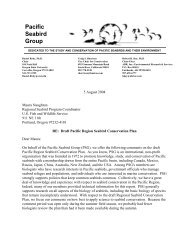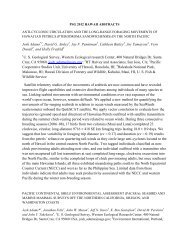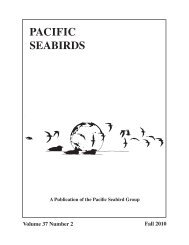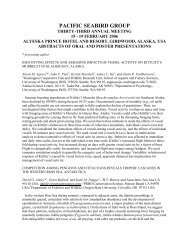abstracts of oral and poster presentations - Pacific Seabird Group
abstracts of oral and poster presentations - Pacific Seabird Group
abstracts of oral and poster presentations - Pacific Seabird Group
You also want an ePaper? Increase the reach of your titles
YUMPU automatically turns print PDFs into web optimized ePapers that Google loves.
POST BREEDING MOVEMENTS AND HABITATS OF THE BLACK-FOOTED ALBATROSS [Poster]<br />
K. David Hyrenbach 1 (khyrenba@duke.edu), Cheryl Baduini 2 , Michelle Hester 3 Carol Keiper 3 , <strong>and</strong> Josh<br />
Adams 4 ; 1 Duke University Marine Lab, Beaufort, NC USA; 2 Claremont Colleges, Claremont, CA USA;<br />
3 Oikonos Ecosystem Knowledge, Bolinas, CA USA; 4 U.S. Geological Survey, Vallejo, CA USA<br />
The Black-footed Albatross (Phoebastria nigripes) is susceptible to bycatch in domestic <strong>and</strong> foreign<br />
longline fisheries across the North <strong>Pacific</strong> Ocean. While large population declines have been projected using<br />
fishing effort <strong>and</strong> bycatch estimates, very little is known about the movements <strong>and</strong> threats faced by individual<br />
albatrosses at-sea, especially during their post-breeding dispersal. To investigate Black-footed Albatross<br />
distribution, habitat-use, <strong>and</strong> overlap with longline fisheries, we tracked the movements <strong>of</strong> nine birds (4 females<br />
<strong>and</strong> 5 males) using 54-g ARGOS transmitters. The birds were caught at-sea within the Cordell Bank National<br />
Marine Sanctuary, <strong>of</strong>f central California, <strong>and</strong> tracked from July to October 2004. We obtained location data for<br />
an average <strong>of</strong> 45 days (range 34–58 d for 5 continuous tags; 32–58 d for 4 tags on 24 hr on/24 hr <strong>of</strong>f duty cycle).<br />
Seven <strong>of</strong> the tracked individuals departed Cordell Bank in a southwest direction <strong>and</strong> then looped back towards<br />
northern latitudes (45–50°N), with the other two birds remaining farther south (20–30°N). All <strong>of</strong> the satellitetracked<br />
birds ventured beyond the US Exclusive Economic Zone, with three <strong>of</strong> them traveling west <strong>of</strong> the<br />
International Dateline. Our results suggest that post-breeding Black-footed Albatrosses do not remain within<br />
sanctuary waters but instead range widely across areas targeted by pelagic longline fisheries.<br />
CLIMATE CHANGE AND MURRES: A CIRCUMPOLAR SEESAW<br />
David B. Irons 1 (david_irons@fws.gov), Tycho Anker-Nilssen, Anthony J. Gaston, G. Vernon Byrd, Knud Falk,<br />
Grant Gilchrist, Martti Hario, Måns Hjernquis, Yuri V. Krasnov, Anders Mosbech, Jim Reid, Greg Robertson,<br />
Bergur Olsen, Aevar Petersen, Hallvard Strom, <strong>and</strong> Kenton D. Wohl 1 ; 1 U. S. Fish <strong>and</strong> Wildlife Service,<br />
Anchorage, AK USA<br />
Data on murre population trends from 52 colonies, involving more than 490 colony-years, from around<br />
the world were brought together for a circumpolar perspective <strong>of</strong> the effects <strong>of</strong> climate change on seabird<br />
populations. Circumpolar changes in Common <strong>and</strong> Thick-billed murre populations over the past 25 years were<br />
associated with decadal shifts <strong>of</strong> northern hemisphere atmospheric oscillations, the <strong>Pacific</strong> Decadal Oscillation<br />
<strong>and</strong> the North Atlantic Oscillation. These oscillations are correlated with decadal changes in ocean<br />
temperatures. The long-term sea surface temperature (SST) trends in the northeast Atlantic <strong>and</strong> the northeast<br />
<strong>Pacific</strong> mirrored each other resulting in a “seesaw” effect. When the northeast Atlantic cooled, the northeast<br />
<strong>Pacific</strong> warmed, <strong>and</strong> vice versa. Murre populations were in a constant flux: when SST shifted slightly<br />
(~0.5°C),<br />
murre populations declined. The two species reacted somewhat differently to SST shifts. Thick-billed Murres,<br />
the arctic-adapted species, did better when the SST increased slightly, <strong>and</strong> the more temperate Common Murre<br />
did better when the SST decreased slightly.<br />
SITE FIDELITY AND THE DEMOGRAPHIC IMPLICATIONS OF WINTER MOVEMENTS BY A<br />
MIGRATORY BIRD: THE HARLEQUIN DUCK<br />
Sam Iverson (siverson@sfu.ca) <strong>and</strong> Dan Esler; Centre for Wildlife Ecology, Simon Fraser University,<br />
Burnaby, BC CANADA<br />
Underst<strong>and</strong>ing the degree <strong>of</strong> demographic connectivity among population segments is central to the<br />
fields <strong>of</strong> population ecology <strong>and</strong> conservation biology. However, delineating demographically discrete<br />
population units has proven challenging, particularly for migratory birds. We used radio-telemetry to document<br />
winter site fidelity, movement patterns, <strong>and</strong> the spatial scale <strong>of</strong> demographic independence <strong>of</strong> Harlequin Ducks<br />
(Histrionicus histrionicus) in Prince William Sound, Alaska. During the winters <strong>of</strong> 1995–1996 through 1997–<br />
1998 <strong>and</strong> 2000–2001 through 2002–2003, 434 females were implanted with transmitters <strong>and</strong> their signals<br />
tracked from aircraft. Using a spatially nested design, we determined that 75% <strong>of</strong> radioed females remained in<br />
the bay or coastline area (mean area ± SE = 16.7 ± 1.5 km 2 ) where they were originally trapped, 94% remained<br />
on the same isl<strong>and</strong> or mainl<strong>and</strong> region within Prince William Sound (127.5 ± 39.1 km 2 ), <strong>and</strong> fewer than 2%<br />
emigrated from the 4,500-km 2 study area as a whole. Estimates for population size, survival, <strong>and</strong> movement<br />
rates were incorporated into a demographic model, the results <strong>of</strong> which indicated immigrant females accounted


